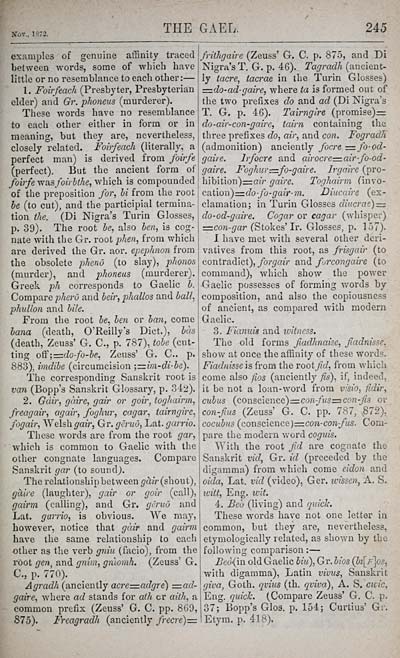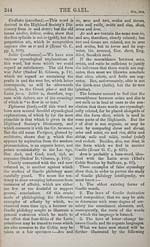Hew Morrison Collection > Gaidheal > 1 Leabh 2 Air
(223)
Download files
Complete book:
Individual page:
Thumbnail gallery: Grid view | List view

THE GAEL
245
examples of genuine affinity traced
between words, some of which have
little or no resemblance to each other: —
1. Foirfeach (Presbyter, Presbyterian
elder) and Gr. phoneus (murderer).
These words have no resemblance
to each other either in form or in
meaning, but they are, nevertheless,
closely related. Foirfeach (literally, a
perfect man) is derived from foirfe
(perfect). But the ancient form of
foirfe wasfoirhthe, which is compounded ,
of the preposition for, hi from the root
he (to cut), and the participial termina-
tion the. (Di Nigra's Turin Glosses,
p. 39). The root be, also ben, is cog-
nate with the Gr. root j^hen, from which
are derived the Gr. aor. epephnon from
the obsolete phenu (to slay), phonos
(murder), and p)honeus (murderer).
Greek ph corresponds to Gaelic b.
Compare pherO and heir, phallos and ball,
phullon and bile.
From the root he, hen or ban, come
hana (death, O'Reilly's Diet.), has
(death, Zeuss' G. C., p. 787), tobe (cut-
ting oS ;=dofo-be, Zeuss' G. C.. p.
883), imdibe (circumcision •,-=im-cli-he).
The corresponding Sanskrit root is
van (Bopp's Sanskrit Glossary, p. 342).
2. Gàir, glare, gair or goir, toghairm,
freagair, agair, foghur, cagar, iairngire,
fogair, Welsh gair, Gr. gèruO, Lat. garrio.
These words are from the root gar,
which is common to Gaelic with the
other congnate languages. Compare
Sanskrit gar (to soundj.
The relationship between gair {sXioni),
gàire (laughter), gair or goir (call),
gairm (calling), and Gr. gèriio and
Lat. garrio, is obvious. AVe may,
however, notice that gair and gairm
have the same relationship to each
other as the verb gniu (facio), from the
root gen^ and gnim, gniomh. (Zeuss' G.
C, p. 770).
Agradh (anciently acre-=adgre^ =:ad-
gaire, Avhere ad stands for ath cr aith, a
common prefix (Zeuss' G. C. pp. 8G9,
875). Freagradh (anciently frecre)-=z
frithgaire (Zeuss' G. C. p. 875, and Di
Nigra's T. G. p. 46). Tagradh (ancient-
ly tacre, tacrae in the Turin Glosses)
=do-ad-gaire, where ta is formed out of
the two prefixes do and ad (Di Nigra's
T. G. p. 46). Tairngire (promise)=
do-air-con-gaire, tairn containing the
three prefixes do, air, and con. Fogradh
(admonition) anciently focre =fo-od-
gaire. Irfocre and airocre-=.air-fo-od-
gaire. Foghur:=fo-gaire. Irgaire (pro-
hibition)=a/?- gaire. Toghairm (invo-
tiii\on)=ido-fo-gair-m. Diucaire (ex-
clamation; in Turin Glosses diucrae)-=:i
do-od-gaire, Cogar or cagar (whisper)
=con-5rar (Stokes' Ir. Glosses, p. 157).
I have met with several other deri-
vatives from this root, as frisgair (to
contradict), forgair and fuvcongaire (to
command), which show the power
Oaelic possesses of forming words by
composition, and also the copiousness
of ancient, as compared with modern
Gaelic.
3. Fiamiis and ivitncss.
The old forms fiadhnaise, fiadnisse,
show at once the affinity of these words.
Fiadnisse is from the root fid, from which
come also fios (anciently fis), if, indeed,
it be not a loan-word from vfsio, fidir,
cuius {consc\encc)=confus=sconfis or
con-fats (Zeuss' G. C. pp. 787, ,872),
cocubns (consc\erice)=:con-con-fus. Com-
pare tlie modern word coguis.
With the root fd are cognate the
Sanskrit vid, Gr. id (preceded by the
digamma) from which come cidon and
oida, Lat. vid (video), Ger. tvisscn, A. S.
ivitt, Eng. wit.
4. Beo (living) and qiticJc.
These words have not one letter in
common, but they are, nevertheless,
etymologically related, as shown by the
following comparison : —
Bcò{ìn old Gaelic bin), Gr. bios (bi[F\os,
with digamma), Latin vivus, Sanskrit
gii'a, Goth, qvius (th. qviva), A. S. civic,
Eng. quicJc. (^Compare Zeuss' G. C. p.
37; Bopp's Glos. p. 154; Curtius' Gr.
Etyra. p. 418).
245
examples of genuine affinity traced
between words, some of which have
little or no resemblance to each other: —
1. Foirfeach (Presbyter, Presbyterian
elder) and Gr. phoneus (murderer).
These words have no resemblance
to each other either in form or in
meaning, but they are, nevertheless,
closely related. Foirfeach (literally, a
perfect man) is derived from foirfe
(perfect). But the ancient form of
foirfe wasfoirhthe, which is compounded ,
of the preposition for, hi from the root
he (to cut), and the participial termina-
tion the. (Di Nigra's Turin Glosses,
p. 39). The root be, also ben, is cog-
nate with the Gr. root j^hen, from which
are derived the Gr. aor. epephnon from
the obsolete phenu (to slay), phonos
(murder), and p)honeus (murderer).
Greek ph corresponds to Gaelic b.
Compare pherO and heir, phallos and ball,
phullon and bile.
From the root he, hen or ban, come
hana (death, O'Reilly's Diet.), has
(death, Zeuss' G. C., p. 787), tobe (cut-
ting oS ;=dofo-be, Zeuss' G. C.. p.
883), imdibe (circumcision •,-=im-cli-he).
The corresponding Sanskrit root is
van (Bopp's Sanskrit Glossary, p. 342).
2. Gàir, glare, gair or goir, toghairm,
freagair, agair, foghur, cagar, iairngire,
fogair, Welsh gair, Gr. gèruO, Lat. garrio.
These words are from the root gar,
which is common to Gaelic with the
other congnate languages. Compare
Sanskrit gar (to soundj.
The relationship between gair {sXioni),
gàire (laughter), gair or goir (call),
gairm (calling), and Gr. gèriio and
Lat. garrio, is obvious. AVe may,
however, notice that gair and gairm
have the same relationship to each
other as the verb gniu (facio), from the
root gen^ and gnim, gniomh. (Zeuss' G.
C, p. 770).
Agradh (anciently acre-=adgre^ =:ad-
gaire, Avhere ad stands for ath cr aith, a
common prefix (Zeuss' G. C. pp. 8G9,
875). Freagradh (anciently frecre)-=z
frithgaire (Zeuss' G. C. p. 875, and Di
Nigra's T. G. p. 46). Tagradh (ancient-
ly tacre, tacrae in the Turin Glosses)
=do-ad-gaire, where ta is formed out of
the two prefixes do and ad (Di Nigra's
T. G. p. 46). Tairngire (promise)=
do-air-con-gaire, tairn containing the
three prefixes do, air, and con. Fogradh
(admonition) anciently focre =fo-od-
gaire. Irfocre and airocre-=.air-fo-od-
gaire. Foghur:=fo-gaire. Irgaire (pro-
hibition)=a/?- gaire. Toghairm (invo-
tiii\on)=ido-fo-gair-m. Diucaire (ex-
clamation; in Turin Glosses diucrae)-=:i
do-od-gaire, Cogar or cagar (whisper)
=con-5rar (Stokes' Ir. Glosses, p. 157).
I have met with several other deri-
vatives from this root, as frisgair (to
contradict), forgair and fuvcongaire (to
command), which show the power
Oaelic possesses of forming words by
composition, and also the copiousness
of ancient, as compared with modern
Gaelic.
3. Fiamiis and ivitncss.
The old forms fiadhnaise, fiadnisse,
show at once the affinity of these words.
Fiadnisse is from the root fid, from which
come also fios (anciently fis), if, indeed,
it be not a loan-word from vfsio, fidir,
cuius {consc\encc)=confus=sconfis or
con-fats (Zeuss' G. C. pp. 787, ,872),
cocubns (consc\erice)=:con-con-fus. Com-
pare tlie modern word coguis.
With the root fd are cognate the
Sanskrit vid, Gr. id (preceded by the
digamma) from which come cidon and
oida, Lat. vid (video), Ger. tvisscn, A. S.
ivitt, Eng. wit.
4. Beo (living) and qiticJc.
These words have not one letter in
common, but they are, nevertheless,
etymologically related, as shown by the
following comparison : —
Bcò{ìn old Gaelic bin), Gr. bios (bi[F\os,
with digamma), Latin vivus, Sanskrit
gii'a, Goth, qvius (th. qviva), A. S. civic,
Eng. quicJc. (^Compare Zeuss' G. C. p.
37; Bopp's Glos. p. 154; Curtius' Gr.
Etyra. p. 418).
Set display mode to: Large image | Transcription
Images and transcriptions on this page, including medium image downloads, may be used under the Creative Commons Attribution 4.0 International Licence unless otherwise stated. ![]()
| Early Gaelic Book Collections > Hew Morrison Collection > Gaidheal > 1 Leabh 2 Air > (223) |
|---|
| Permanent URL | https://digital.nls.uk/76797628 |
|---|
| Attribution and copyright: |
|
|---|---|
| Description | A selection of items from a collection of 320 volumes and 30 pamphlets of literary and religious works in Scottish Gaelic. From the personal library of Hew Morrison, the first City Librarian of Edinburgh. |
|---|
| Description | Selected items from five 'Special and Named Printed Collections'. Includes books in Gaelic and other Celtic languages, works about the Gaels, their languages, literature, culture and history. |
|---|

